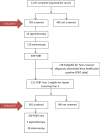Longitudinal predictors of colorectal cancer screening among participants in a randomized controlled trial
- PMID: 24937648
- PMCID: PMC4209306
- DOI: 10.1016/j.ypmed.2014.06.013
Longitudinal predictors of colorectal cancer screening among participants in a randomized controlled trial
Abstract
Objective: Few studies use longitudinal data to identify predictors of colorectal cancer screening (CRCS). We examined predictors of (1) initial CRCS during the first year of a randomized trial, and (2) repeat CRCS during the second year of the trial among those that completed FOBT in Year 1.
Methods: The sample comprised 1247 participants of the Systems of Support to Increase Colorectal Cancer Screening (SOS) Trial (Group Health Cooperative, August 2008 to November 2011). Potential predictors of CRCS were identified with logistic regression and included sociodemographics, health history, and validated scales of psychosocial constructs.
Results: Prior CRCS (OR 2.64, 95% CI 1.99-3.52) and intervention group (Automated: OR 2.06 95% CI 1.43-2.95; Assisted: OR 4.03, 95% CI 2.69-6.03; Navigated: OR 5.64, 95% CI 3.74-8.49) were predictors of CRCS completion at Year 1. For repeat CRCS at Year 2, prior CRCS at baseline (OR 1.97, 95% CI 1.25-3.11), intervention group (Automated: OR 9.27, 95% CI 4.56-18.82; Assisted: OR 11.17, 95% CI 5.44-22.94; Navigated: OR 13.10, 95% CI 6.33-27.08), and self-efficacy (OR 1.32, 95% CI 1.00-1.73) were significant predictors.
Conclusion: Self-efficacy and prior CRCS are important predictors of future screening behavior. CRCS completion increased when access barriers were removed through interventions.
Trial registration: ClinicalTrials.gov NCT00697047.
Keywords: Behavioral intervention research; Cancer screening; Colorectal cancer; Longitudinal study.
Copyright © 2014 Elsevier Inc. All rights reserved.
References
-
- Bastani R, Maxwell AE, Bradford C. Cross-section versus prospective predictors of screening mammography. Cancer Epidemiol. Biomarkers Prev. 1996;5(10):845–848. - PubMed
-
- Breslau N, Reeb KG. Continuity of care in a university-based practice. J. Med. Educ. 1975;50(10):965–969. - PubMed
-
- Centers for Disease Control, Prevention (CDC) Cancer screening—United States, 2010. MMWR Morb. Mortal. Wkly Rep. 2012;61(3):41–45. - PubMed
-
- Church TR, Yeazel MW, Jones RM, Kochevar LK, Watt GD, Mongin SJ, et al. A randomized trial of direct mailing of fecal occult blood tests to increase colorectal cancer screening. J. Natl. Cancer Inst. 2004;96(10):770–780. - PubMed
-
- Coronado GD, Golovaty I, Longton G, Levy L, Jimenez R. Effectiveness of a clinic-based colorectal cancer screening promotion program for underserved Hispanics. Cancer. 2011;117(8):1745–1754. - PubMed
Publication types
MeSH terms
Associated data
Grants and funding
LinkOut - more resources
Full Text Sources
Other Literature Sources
Medical


